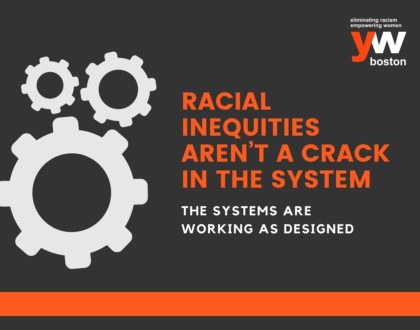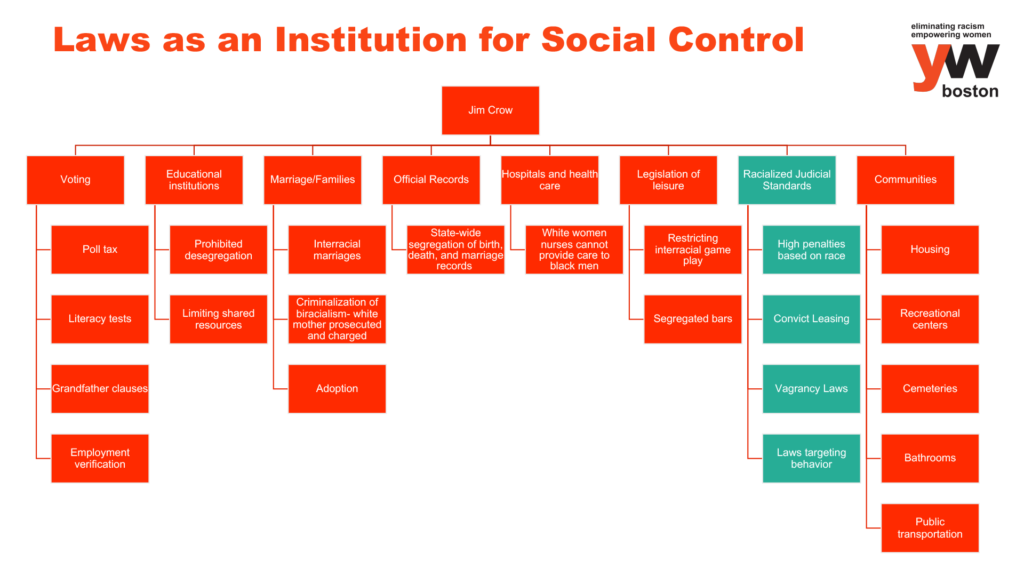Racial inequities aren’t a crack in the system – the systems are working as designed

It is common, in the aftermath of a tragedy, for Americans to state that our systems are broken. In the aftermath of George Floyd’s murder, it was said that the police system was broken. And that the criminal justice system was broken when Kyle Rittenhouse was acquitted for killing Black Lives Matter protestors. COVID-19 infection and vaccine disparities seemed to reveal a broken healthcare system.
This is an understandable reaction to recognizing a disconnect between our country’s declared values and its real-life outcomes. The United States’ founding document, the Declaration of Independence, stated preservation of “life, liberty, and the pursuit of happiness.” The disparities we see across racial, gender, and economic divides do not align with these values. And yet, rather than believing we have veered off the path of our country’s founding, we must recognize that there has always been a disconnect between those stated values and how our systems have been formed.
In fact, our systems are working as they were designed. Deep inequities were present at our country’s founding and have been a through line until today. And therefore, discriminatory beliefs and practices have been built into our systems – those formed by the government and by our institutions. These systems, from education to class, and everything in between, have been created by those who have held power in the situation, and therefore have been set up to benefit them.
We must see our systems clearly in order to rebuild them. Creating patches that improve certain areas but don’t alter the underlying structure of inequitable systems is not enough.
At YW Boston, we seek to help our community recognize how the systems we interact with on a daily basis were set up as they are, the inequitable outcomes this produces, and how to move forward toward an equitable future. In this blog post, we will learn about how racism, in particular, has been built into systems, and why it is crucial for organizations to examine the systems they interact with daily.
The construction of race is a backbone to our systems
Something is systemic in nature when it is spread throughout, affecting a group or system, such as a body, economy, market or society as a whole, and embedded as normal practice within society or an organization. Systems of advantage or disadvantage (racism, sexism, ableism, etc.) refer to the policies and practices engrained in our daily lives that benefit people of certain social identities over others, thereby maintaining the power held by those who are considered to have ‘privileged’ identities.
Racism, a system of advantage based on race, is an integral part of the how many of our nation’s other systems, such as our criminal justice system, were crafted. This is why race as Americans understand the concept today was formed. As the National Museum of African American History and Culture (NMAAHC) explains, prior to American colonization, “race” was used rarely and generally meant to group people by kinship, rather than shared physical characteristics. However, racial categories as we know them today became more commonplace as the “categorization of people became a justification for European colonization and subsequent enslavement of people from Africa.”
We also know that the conception of who is White has evolved over time, with the term first used as a way to collect power against Native Americans, enslaved Africans, and non-Anglo Saxon immigrants. This meant that groups such as Irish, Italian, and Eastern European Americans were long thought not to be White. However, according to the NMAAHC the category of White “would expand as people wanted to push back against the increasing numbers of people of color due to emancipation and immigration,” thereby collecting greater power for those considered White. Through this example, we see that constructions of race have long evolved to fit the needs of those with power and privilege.
European colonization and the founding of the United States of America depended on this construction of race, thereby ensuring that race was interwoven into our nation’s policies and practices. Pulitzer Prize winning author Isabel Wilkerson has found that race is the primary factor in how we divide the people of our country, referring to this system as caste. As she explains, a “caste system uses rigid, often arbitrary boundaries to keep the ranks apart, distinct from one another and in their assigned places…In America, race is the primary tool and the visible decoy for caste.” Understanding that race has been and still is the central way that we divide, and therefore understand, our nation helps us see that it has necessarily been built into the core of our institutions.

Inequitable outcomes are a product of intentional design
Because racism, this system of advantage, is central to the institutions, the racial disparities we see today are expected outcomes based on intentional design. Many systems today perpetuate and uphold long-standing inequities. Let us take a brief look at two systems in particular, which often are said to be broken, to understand how they are running as designed: criminal justice and housing.
Our criminal justice system is purported to be based on humanistic values – that one is innocent until proven guilty and that everyone has the right to a free trial before a jury. And yet, Black Americans are incarcerated at nearly five times the rate of White Americans, an issue that cannot be explained simply by the individual racism of the judge and jury. Jim Crow laws, named for a racist Black minstrel show character, were a collection of state and local laws that legalized racial segregation directly after slavery was abolished – a tactic to both limit the power of formerly enslaved people and to utilize forced labor in the form of imprisonment. While Jim Crow was abolished with the Civil Rights Act of 1964, those in power simply changed tactics – continuing to incarcerate Black men through legislation tied to the “War on Drugs.” This covert approach remains an effective way to keep power out of the hands of Black Americans and utilize their labor in prison. Thus, the disparities in incarceration are due to the design of the legislative system altogether. You can learn more about this from Michelle Alexander’s The New Jim Crow.
We see a similar pattern built into our housing system. In response to the Great Depression, the New Deal included housing programs – programs which intentionally shut out Black Americans. On top of this, the newly established Federal Housing Administration refused to insurance mortgages in and near Black neighborhoods, a process called redlining. Over the past century, mortgage insurers have not always explicitly stated that race is a reason for denying coverage, instead color coding these neighborhoods as “risky”. But the racism was overt in the Federal Housing Administration’s manual, which stated that “incompatible racial groups should not be permitted to live in the same communities.” Today, credit scores are used as a form of redlining, disproportionally impacting Black and Latino households. Home ownership is one of the most secure ways for families to accrue wealth. As a result of redlining policies, White households have a median wealth that is ten times that of Black households and eight times that of Latino households. You can learn more about this in Richard Rothstein’s The Color of Law.
Racism is the crucial system of advantage that is built into our country’s policies and practices, but it isn’t the only one. Sexism, ableism, classism, and all other systems of advantage have been engrained in our institutions over time. We must take a intersectional approach to understanding identity and systems, so that can understand how these systems work in tandem.
When approaching DEI, organizations must take a look at the systems they are built on and uphold
Every organization, regardless of industry, must reckon with its relationship to inequitably designed systems. No workplace is immune and this recognition requires hard work from leaders, staff, and community members to learn, reflect, and rebuild.
Racism will not be eliminated by creating band-aid approaches to what seem like cracks in the system. Instead, we must rebuild new solutions that are actively anti-racist. Understanding the mechanisms in which racism is built into our country’s systems gives us the opportunity to see more clearly where we have the power to make change.
Our DEI Services provides partners with the opportunity for their staff to learn about how their organization is impacted by systemic racism and to discuss. Our InclusionBoston partnership, in particular, zones in on industry specifics and helps connect personal experiences to the systemic inequities that persist. Specifically, the partnership helps organizations and their staff see how systems were designed and have evolved over time. With this shared understanding and planning, staff build their ability to identify inequitable systems and work together to create solutions.
Learn more about systemic inequities, and the connection to collective violence.
If you need support holding these conversations at your organization and wish to work towards a more inclusive and equitable workplace, click here to learn more about InclusionBoston or contact Sheera Bornstein at sheera@ywboston.org to learn more about our DEI Services.
______
About YW Boston
As the first YWCA in the nation, YW Boston has been at the forefront of advancing equity for over 150 years. Through our DE&I services—InclusionBoston and LeadBoston—as well as our advocacy work and F.Y.R.E. Initiative, we help individuals and organizations change policies, practices, attitudes, and behaviors with a goal of creating more inclusive environments where women, people of color, and especially women of color can succeed.
Whether your organization is large or small, you’re just starting out with DEI, or are further along on the journey, YW Boston will work with you to find the right solutions. YW Boston offers a variety of DEI Services designed to create lasting change. For more information, please contact Sheera Bornstein at sheera@ywboston.org.
About InclusionBoston
InclusionBoston advances diversity, equity, and inclusion by partnering with organizations looking for improved results. Using our advanced assessment tool and the latest research on behavioral and organizational change, we partner with organizations to create an action plan and provide them with the resources needed to drive lasting change. Our customized, evidence-based approach builds internal capacity and promotes cultural change while supporting organizations throughout their journey. YW Boston also offers one-day workshops where participants explore frameworks, develop knowledge, and engage in dialogue.
Ready to unlock the power of diversity in the workplace? Click here to learn more about InclusionBoston and request your free consultation.
